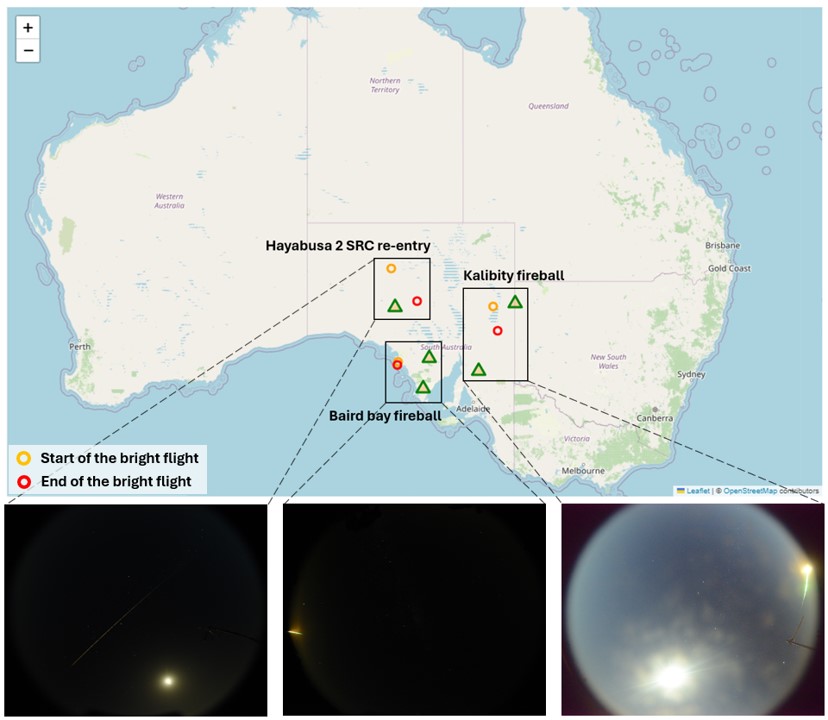Seismo-acoustic signals of fireballs: Comparing natural objects to a man-made sample return capsule entry.
- 1Space Science and Technology Centre, Curtin University, Perth, Australia (iona.clemente@postgrad.curtin.edu.au)
- 2International Centre for Radio Astronomy Research, Curtin University, Perth, Australia
Fireballs are unpredictable phenomena from large objects entering our atmosphere that continue to be the subject of numerous studies. Indeed, as they tend to last from a few seconds to several dozen seconds, and as we usually do not have samples of these bodies, we are missing a lot of information about their properties.
Nevertheless, we know that when a meteoroid is large enough; greater than 10 centimetres diameter, it produces shock waves. These waves are either generated by the hypersonic passage of the meteoroid through the atmosphere, or by the fragmentation process. Indeed, a meteoroid undergoes fragmentation when the air pressure exerted over its surface exceeds its cohesion. In addition, surface waves such as Rayleigh waves, can also be induced by the coupling of shock waves with the ground. In the extremely rare case of an impact of the meteoroid on the ground, body waves may be generated as well.
In this study, we decided to focus on three main events: two metre-scale fireball entries and one re-entry event. The first event, the Kalabity event, occurred on January 2nd, 2015, and lasted 10.54 seconds (Devillepoix et al. (2019)). The meteoroid diameter was estimated by Devillepoix et al. (2019) to be approximately 1.2 metre. Baird bay event, the second metre-scale event occurred on June 30th, 2017. It lasted 5.46 seconds and was estimated to be greater than 1.7-metre diameter (Devillepoix et al. (2019)). The last event we are investigating is the re-entry of the SRC of Hayabusa 2. For context, the aim of this Japanese was to recover samples at the surface of the Ryugu asteroid and to bring them back to Earth for analyses. The SRC re-entry took place on January 5th, 2020, over the Woomera Prohibited are, South Australia, and persisted for 26.4 seconds.
In this work, we analyse the seismic signals recorded from these events with the aim of identifying characteristic properties and differences between the entry of natural bodies that fragment, and a man-made 'monolith' type object.
For our seismic investigation, we use fireball trajectory information from the Desert Fireball Network (DFN) database and seismic data from seismic stations of the Australian National Seismograph Network (ANSN). Regarding the first meter-scale event (Kalabity event), interesting signals have been found at seismic stations AQ3G0 and HTT, respectively belonging to the 4J and AU networks. Similarly, stations BBOO (AU) and AUCAS (S1) display a likely signal from the Baird bay event. Additionally, one seismic station, MULG (network AU), provide interesting seismic data of the re-entry of Hayabusa 2.

Figure 1: Events locations.
References
H. A. R. Devillepoix, P. A. Bland, E. K. Sansom, M. C. Towner, M. Cupák, R. M. Howie, B. A. D. Hartig, T. Jansen-Sturgeon, M. A. Cox, Observation of metre-scale impactors by the Desert Fireball Network, Monthly Notices of the Royal Astronomical Society, Volume 483, Issue 4, March 2019, Pages 5166–5178, https://doi.org/10.1093/mnras/sty3442
Yasuhiro Nishikawa, Masa-yuki Yamamoto, Eleanor K. Sansom, Hadrien A. R. Devillepoix, Martin C. Towner, Yoshihiro Hiramatsu, Taichi Kawamura, Kazuhisa Fujita, Makoto Yoshikawa, Yoshiaki Ishihara, Islam Hamama, Norihisa Segawa, Yoshihiro Kakinami, Hiroshi Katao, Yuichiro Inoue, Philip A. Bland, Modeling of 3D trajectory of Hayabusa2 re-entry based on acoustic observations, Publications of the Astronomical Society of Japan, Volume 74, Issue 2, April 2022, Pages 308–317, https://doi.org/10.1093/pasj/psab126
How to cite: Clemente, I., Sansom, E. K., and Devillepoix, H. A. R.: Seismo-acoustic signals of fireballs: Comparing natural objects to a man-made sample return capsule entry. , Europlanet Science Congress 2024, Berlin, Germany, 8–13 Sep 2024, EPSC2024-846, https://doi.org/10.5194/epsc2024-846, 2024.